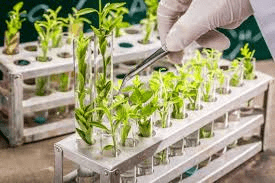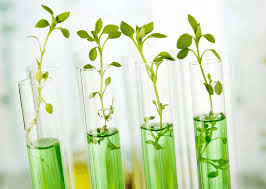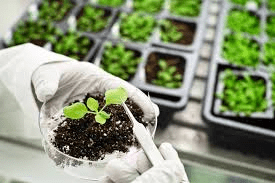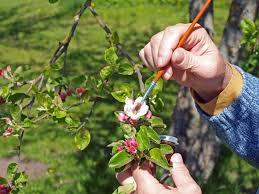Plant breeding is the science of improving plants to develop new varieties with desirable traits such as higher yield, disease resistance, and better nutritional content. This process involves selecting the best plants and using them as parents to produce the next generation of crops.
Over time, plant breeding has helped farmers grow better crops, ensuring food security and sustainability.
History and Evolution of Plant Breeding
1. Early Beginnings: The practice of plant breeding dates back thousands of years. Ancient farmers selected and saved seeds from the best-performing plants to improve crop quality. This was the earliest form of plant breeding, done without any scientific understanding but based on observation and experience.
2. Scientific Foundations: The scientific basis for plant breeding began with the work of Gregor Mendel in the 19th century. Mendel’s experiments with pea plants laid the groundwork for understanding how traits are inherited from one generation to the next, leading to the development of genetics.
3. Modern Plant Breeding: In the 20th century, advances in genetics, molecular biology, and biotechnology transformed plant breeding into a sophisticated science. Today, breeders use tools like DNA markers, genetic engineering, and tissue culture to create new plant varieties more quickly and accurately.
4. Future Directions: As technology continues to evolve, plant breeding is moving towards more precise and sustainable methods. Techniques like gene editing and genomic selection are expected to play a significant role in the future of plant breeding.
Principles of Plant Breeding

1. Genetic Variation: Genetic variation is the foundation of plant breeding. Without variation, there would be no differences in traits to select from. Breeders create or find variation through methods like crossbreeding, mutation, and genetic engineering.
2. Selection: Selection involves choosing plants with the most desirable traits to be parents of the next generation. This can be done through natural selection, where the environment determines which plants thrive, or artificial selection, where humans decide which traits are most valuable.
3. Hybridization: Hybridization is the process of crossing two different plant varieties to combine their traits. The offspring, called hybrids, often show improved characteristics like higher yield or disease resistance.
4. Heritability: Understanding heritability is crucial in plant breeding. It refers to how much of a trait is passed from one generation to the next. Traits with high heritability are easier to improve through breeding.
5. Testing and Evaluation: New plant varieties must be tested and evaluated in different environments to ensure they perform well under various conditions. This step is essential to determine if the new variety is truly an improvement over existing ones.
Types of Plant Breeding
1. Conventional Breeding: Conventional breeding involves traditional methods like selection and crossbreeding. This type of breeding relies on the natural genetic variation within a species to develop new varieties.
2. Mutation Breeding: Mutation breeding involves exposing plants to chemicals or radiation to create genetic mutations. These mutations can lead to new traits that may be beneficial, such as disease resistance or improved growth.
3. Hybrid Breeding: Hybrid breeding focuses on creating hybrids by crossing two genetically different parent plants. Hybrids often exhibit hybrid vigor, meaning they grow better and yield more than either parent.
4. Molecular Breeding: Molecular breeding uses modern tools like DNA markers to identify and select for specific traits at the genetic level. This allows for more precise and efficient breeding.
5. Genetic Engineering: Genetic engineering involves directly altering a plant’s DNA to introduce new traits. This type of breeding can produce crops with specific characteristics, such as pest resistance or enhanced nutritional content.
Goals and Objectives of Plant Breeding
1. Increasing Yield: One of the primary goals of plant breeding is to increase crop yield. Higher-yielding varieties can produce more food on the same amount of land, helping to meet the growing global demand for food.
2. Improving Quality: Breeding efforts also focus on improving the quality of crops. This can include enhancing nutritional content, taste, and texture, as well as improving processing qualities for food manufacturing.
3. Disease Resistance: Developing disease-resistant varieties is crucial to prevent crop losses and reduce the need for chemical pesticides. Breeders work to identify and incorporate genes that provide resistance to common plant diseases.
4. Environmental Adaptation: Another goal is to develop varieties that can thrive in different environmental conditions, such as drought, heat, or cold. This helps ensure stable crop production in the face of climate change.
5. Sustainability: Plant breeding aims to create sustainable farming systems by developing crops that require fewer inputs like water, fertilizers, and pesticides. Sustainable crops help conserve resources and protect the environment.
Read Also: 15 Medicinal Health Benefits of Salvia yangii (Russian Sage)
Methods of Plant Breeding

1. Selection Breeding:
i. Mass Selection: In mass selection, a large number of plants with desirable traits are selected and their seeds are harvested together. This method is simple and effective for improving traits that are easily visible, such as plant height or fruit size.
ii. Pure Line Selection: Pure line selection involves selecting the best individual plants and growing them separately to maintain their desirable traits over generations. This method is used to create uniform and stable varieties.
2. Hybridization:
i. Intraspecific Hybridization: Intraspecific hybridization involves crossing two different varieties of the same species. This method is commonly used to combine desirable traits from both parent varieties.
ii. Interspecific Hybridization: Interspecific hybridization involves crossing plants from different species. This can result in the transfer of unique traits, such as disease resistance, from one species to another.
3. Mutation Breeding:
i. Induced Mutation: Induced mutation involves exposing seeds or plant tissues to radiation or chemicals to create genetic mutations. The resulting plants are screened for beneficial traits, which are then selected for further breeding.
ii. Spontaneous Mutation: Spontaneous mutations occur naturally and can be identified through careful observation of plant populations. Breeders can use these mutations to develop new varieties.
4. Molecular Breeding:
i. Marker-Assisted Selection (MAS): MAS uses DNA markers linked to specific traits to select plants with those traits. This method speeds up the breeding process and increases accuracy.
ii. Genomic Selection: Genomic selection involves analyzing the entire genome of a plant to predict its performance based on genetic information. This method allows breeders to select the best plants more efficiently.
5. Genetic Engineering:
i. Gene Insertion: Gene insertion involves introducing a specific gene into a plant’s genome to confer a desired trait, such as herbicide tolerance or enhanced nutritional content. This method can create crops with traits that are difficult or impossible to achieve through traditional breeding.
ii. CRISPR-Cas9: CRISPR-Cas9 is a precise gene-editing tool that allows breeders to modify specific genes within a plant’s genome. This technology has the potential to revolutionize plant breeding by enabling the development of crops with highly targeted traits.
Classical vs. Modern Plant Breeding Techniques
Plant breeding is the science of developing new plant varieties with desirable traits. This field has evolved significantly, with classical and modern techniques offering different approaches to achieve similar goals.
Classical Plant Breeding
1. Selection: Classical plant breeding often starts with selecting plants that show desirable traits, such as higher yield, disease resistance, or better flavor. The best plants are chosen and bred together over several generations to enhance these traits.
2. Hybridization: This involves crossing two plants with different desirable traits to produce offspring (hybrids) that inherit the best qualities of both parents. For example, one plant might be resistant to a disease, while another has high productivity. Hybridization aims to combine these traits in the new variety.
3. Mutation Breeding: This technique involves exposing plants to chemicals or radiation to induce mutations. Some mutations can lead to beneficial traits, which are then selected and bred into new plant varieties.
Modern Plant Breeding
1. Marker-Assisted Selection (MAS): Modern techniques use genetic markers to identify specific traits at the DNA level. This allows breeders to select plants with desirable traits more precisely and efficiently, even before the plants are fully grown.
2. Genetic Engineering: This involves directly modifying the DNA of a plant to introduce new traits. For example, a gene from a bacterium might be inserted into a plant to make it resistant to pests.
3. Genome Editing (CRISPR): CRISPR is a modern tool that allows scientists to make precise changes to the DNA of a plant. This can be used to enhance traits like drought tolerance or to remove undesirable traits.
Genetic Engineering in Plant Breeding
Genetic engineering is a powerful tool in modern plant breeding. It involves manipulating the DNA of plants to introduce new traits or improve existing ones.
1. Transgenic Plants: These are plants that have been genetically modified by inserting genes from other organisms. For example, Bt cotton is a transgenic plant that contains a gene from the bacterium Bacillus thuringiensis, which makes it resistant to certain pests.
2. Gene Silencing: This technique involves turning off specific genes in a plant’s DNA to eliminate undesirable traits. For example, gene silencing can be used to make a plant less prone to bruising or to reduce the production of harmful chemicals.
3. RNA Interference (RNAi): RNAi is a technique used to suppress the expression of specific genes. It can be used in plant breeding to develop plants with improved resistance to viruses or other diseases.
4. CRISPR-Cas9: CRISPR-Cas9 is a precise genome-editing tool that allows scientists to make targeted changes to a plant’s DNA. It can be used to enhance traits like drought tolerance, improve nutritional content, or increase resistance to diseases.
Read Also: Apple Maggot: Description, Damages Caused, Control and Preventive Measures
Challenges in Plant Breeding

Plant breeding, whether classical or modern, faces several challenges that can impact the development of new plant varieties.
1. Genetic Diversity: One of the biggest challenges in plant breeding is maintaining genetic diversity. Breeding plants with similar traits over many generations can lead to a loss of diversity, making plants more vulnerable to diseases and environmental changes.
2. Environmental Factors: Climate change, pests, and diseases can create unpredictable conditions for plant breeding. Developing plants that can thrive in a changing environment is a major challenge.
3. Time and Cost: Developing a new plant variety can take many years and requires significant financial investment. The process involves multiple stages, from initial selection to field trials and regulatory approval.
4. Consumer Acceptance: Genetically modified plants often face public skepticism and regulatory hurdles. Gaining consumer acceptance for these plants is a challenge that breeders must navigate.
5. Intellectual Property: Protecting the intellectual property rights of new plant varieties can be complex. Breeders need to ensure that their innovations are legally protected, while also navigating the ethical implications of patenting living organisms.
Goals and Objectives of Plant Breeding
Plant breeding is driven by a variety of goals and objectives aimed at improving plants for agriculture and other uses.
1. Improving Yield: One of the primary goals of plant breeding is to develop varieties that produce higher yields. This is essential for meeting the food demands of a growing global population.
2. Enhancing Nutritional Quality: Breeding plants with improved nutritional content is another key objective. This includes increasing the levels of vitamins, minerals, and other essential nutrients in crops like rice, wheat, and maize.
3. Disease Resistance: Developing plants that are resistant to diseases is crucial for reducing crop losses and minimizing the need for chemical pesticides. This also contributes to more sustainable farming practices.
4. Abiotic Stress Tolerance: Breeding plants that can withstand environmental stresses such as drought, salinity, and extreme temperatures is essential for ensuring food security in the face of climate change.
5. Improving Shelf Life: Plant breeding also aims to enhance the shelf life of fruits, vegetables, and grains. This reduces post-harvest losses and ensures that food remains fresh for longer periods.
Ethical Considerations in Plant Breeding
As plant breeding techniques have advanced, so too have the ethical considerations associated with this field.
1. Genetic Modification: The use of genetic engineering and CRISPR technology raises ethical questions about the potential long-term impacts on the environment and human health. There is ongoing debate about the safety and ethics of modifying the DNA of plants.
2. Biodiversity: Breeding plants with specific traits can lead to a reduction in genetic diversity. This poses ethical concerns about the potential loss of traditional crop varieties and the impact on ecosystems.
3. Intellectual Property Rights: Patenting genetically modified plants raises ethical questions about the ownership of living organisms. There is concern that patenting can limit access to important agricultural technologies, particularly in developing countries.
4. Access to Technology: Ensuring that smallholder farmers and developing countries have access to advanced breeding technologies is an important ethical consideration. There is a risk that these technologies could widen the gap between wealthy and poor farmers.
5. Consumer Rights: There are ethical concerns about transparency and consumer choice. Consumers have the right to know if the food they are buying is genetically modified and to make informed decisions about their food.
Future Trends in Plant Breeding
The future of plant breeding is likely to be shaped by several emerging trends and technologies.
1. Precision Breeding: Advances in genome editing, such as CRISPR, will continue to drive precision breeding. This allows for the development of plants with specific traits in a much shorter time frame compared to traditional methods.
2. Sustainable Agriculture: There will be an increasing focus on breeding plants that support sustainable agriculture. This includes developing crops that require fewer inputs, such as water and fertilizers, and that can thrive in diverse ecosystems.
3. Climate-Resilient Crops: As climate change continues to impact agriculture, there will be a growing demand for crops that can withstand extreme weather conditions and fluctuating climates.
4. Nutrient-Enriched Crops: The development of biofortified crops that are enriched with essential nutrients will be a key trend. These crops can play a significant role in addressing malnutrition, particularly in developing countries.
5. Public-Private Partnerships: Collaboration between public institutions and private companies will become increasingly important in advancing plant breeding research and bringing new varieties to market.
Conclusion
Plant breeding is a vital field that has evolved from classical techniques like selection and hybridization to modern methods such as genetic engineering and CRISPR. Each approach offers unique advantages and faces distinct challenges, from maintaining genetic diversity to navigating ethical considerations.
The goals of plant breeding, such as improving yield, enhancing nutritional quality, and developing disease-resistant varieties, are essential for ensuring food security and sustainability. As we look to the future, trends like precision breeding, sustainable agriculture, and the development of climate-resilient crops will play a crucial role in shaping the next generation of plants.
Understanding these dynamics is key for anyone involved in agriculture, from farmers to policymakers, as we work towards a more sustainable and food-secure world.
Read Also: How to Grow Microgreens
Frequently Asked Questions
We will update this section soon.

